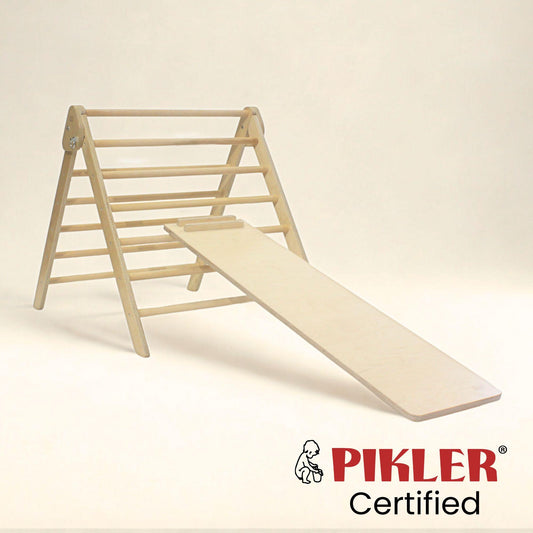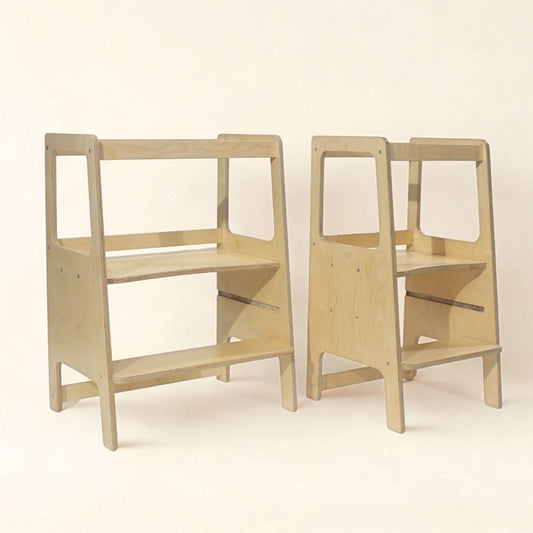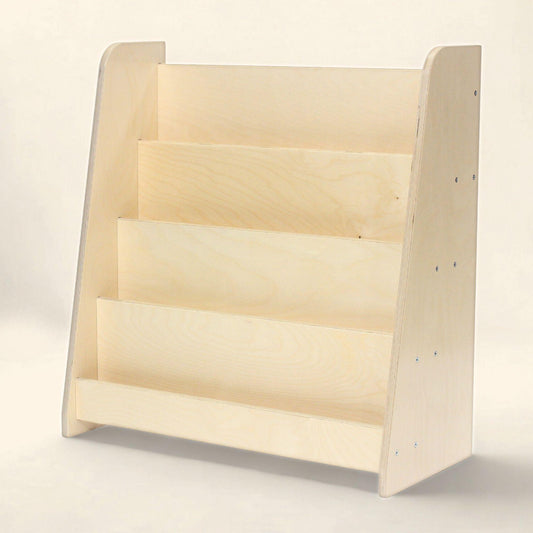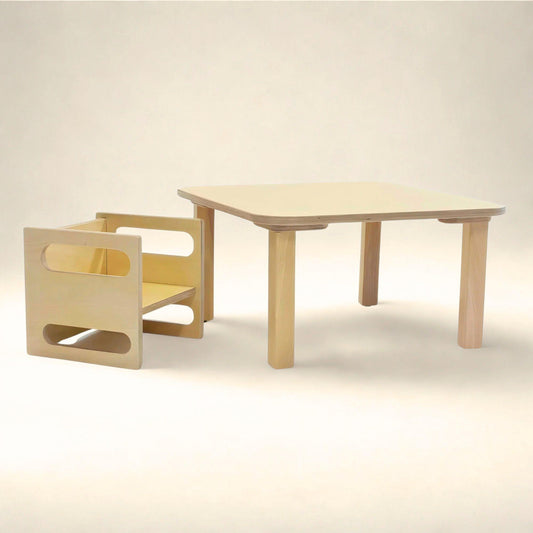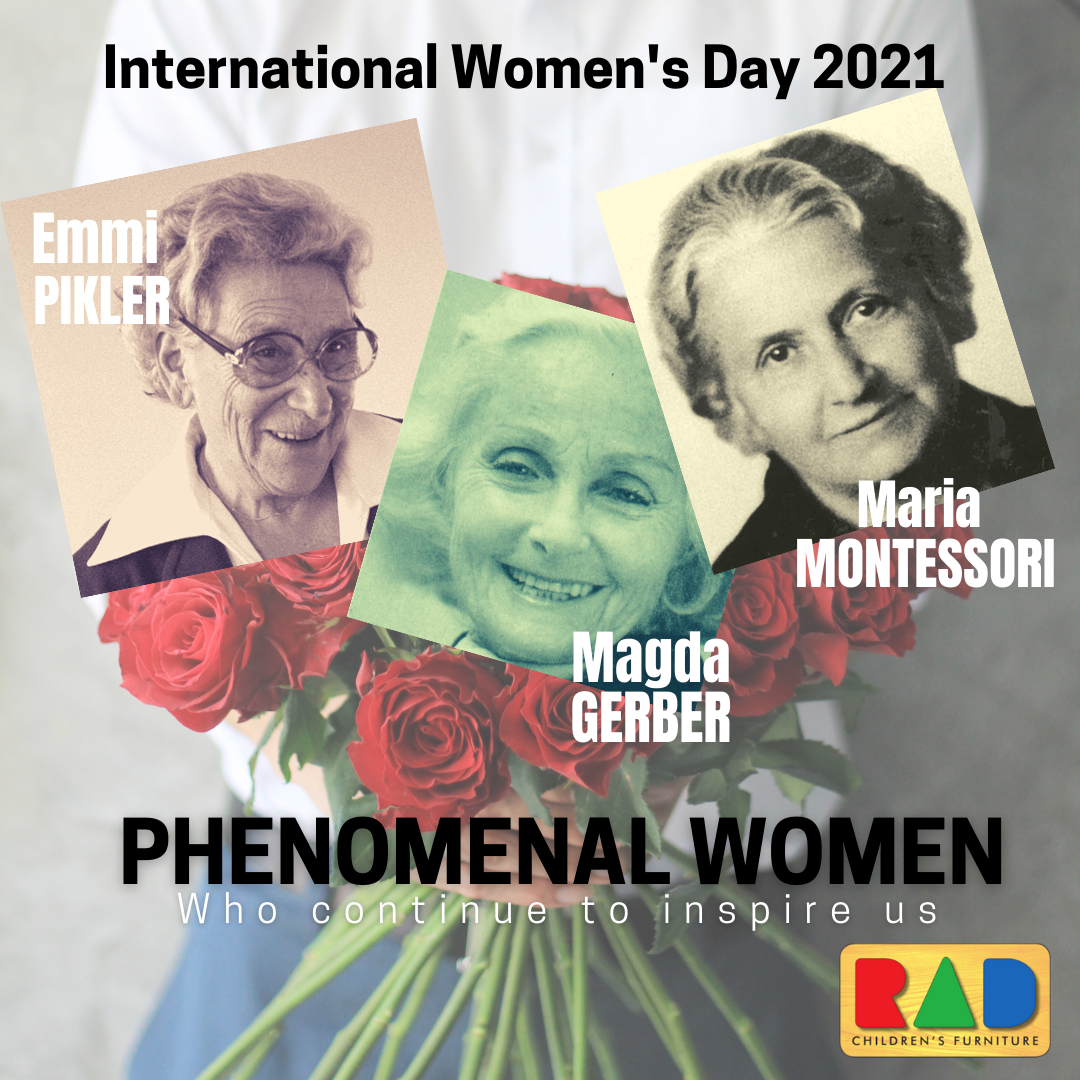
We Celebrate the Powerful and Progressive Women at the Core of our Products
Share
We eagerly celebrate International Women’s Day every year. Not only did the concept for our company come from a woman, but our products are also founded on schools of thought by progressive women educators who lived decades ago and still endure today as thought leaders for new generations of parents.
Our beloved trifecta of early infant and childhood educators are Emmi Pikler, her protégé Magda Gerber and the world renown pediatrician Maria Montessori.
Emmi Pikler | Emmi was a forward-thinker in a time when children were viewed as subject to their parents. She challenged this notion as she uncovered the vital importance of relationship between parents and their children to promote healthy development. In today’s psychological vernacular, Emmi’s early work addressed the concept of attachment.
In this work, she uncovered healthy and natural methodologies on how to parent with respect, how to source indoor play equipment and materials to promote gross motor development. One of the mainstays of equipment she ideated is the Pikler triangle that RAD Children’s Furniture pairs with several add-ons such as climbing ramps, ladders, balance beams, boxes and other items that encourage the imaginative play that was highly touted by this early infant educator.
Emmi mapped out a general timeline within which a child’s motor development unfolds naturally which she then documented through decades of research and keen, consistent observation. Although several decades old, this research serves as today’s basis for charting natural developmental patterns.
In performing this work, Emmi set the standard and a curriculum designed to help parents and other caregivers learn a new way to raise children in a then revolutionary manner – with respect. She successfully applied her practicum within family structures and institutions, applying her methodologies to young babies through middle childhood. We’re talking the 1920s. Continuing to today, these ideas were continue to serve growing families globally.
Much of Emmi’s work was done by careful, highly intentional observing. Back in the day, less affluent children played in the streets and wealthier ones were raised under the watchful eye of a vigilant governess. As logic – and Emmi’s observation would have it – it was “discovered” that children who enjoyed the freedom to roam, run and play were likely to be more alert, more physically capable, and able to fall without sustaining injury.
In the early 1930s Emmi married and had a daughter, Anna. She and her husband decided to do everything possible to assure the healthy development of their first child, allowing plenty of space and time for the natural unfoldment of her physical development without forcing it all within the context of a solid, caring and respectful relationship. She proved validity of her hypothesis that a child who is allowed to explore at her own pace learns how to sit, stand, walk, speak and think better than a child who is prodded to fit into developmental stages.
In her private pediatric practice, Dr. Pikler served hundreds of families in Vienna and Trieste. In serving her patients and through the process of raising own daughter, she expanded her knowledge base that led to the creation of Pikler Triangles and other gross motor skill enhancing play structures. She inspired and attracted a circle of child-centric medical professions including Elsa Gindler and her student Elfriede Hengstenberg, whose RAD Children’s Furniture ladder is part of our play structure inventory.
The Gindler-Pikler-Hengstenberg informal alliance recognized the relationship between the emotional and the physical influence on the structure of the body. Their work led to knowledge about the inner laws of movement govern the body, unfolding when given the opportunity and the right environment. Where Gindler and Hengstenberg focused on correcting body misalignments, Emmi’s focus was preventative, supporting natural development and the influence it has on emotional security and secure, organic growth, balance, poise, self-discovery and confidence.
In the late 1930s Magda Geber had become a great supporter of Emmi’s work. She introduced and then expanded the Pikler ideas to the English-speaking world through the organization Resources for Infant Educarers (RIE), which she established in 1978 together with Tom Forrest, M.D.
Emmi is sometimes referred to as a first teacher and the originator of her approach that continues serve as the blueprint for parents, early childhood educators, pediatricians across cultures, geographies and languages who support her natural and cooperative working relationship between children, families and caregivers to produce healthy, thriving children and happier parents.
Magda Gerber | Magda brings us the concept of educaring, a philosophy of childcare and engagement that challenges a parent to view infants through new eyes, urging us to respect our babies as whole and complete beings from Day One. She invites us to become diligent observers of our children and to allow them to develop naturally without the need to helicopter or intervene as they play and grow.
She is the founder of Resources for Infant Educarers, that teaches parents and other caregivers to actively and intently listen to children’s thoughts and feelings as we encourage them to explore the world through play and to teach values by modeling, rather than by force.
Magda’s concept of educaring suggests we strive for a bilateral relationship with our children based on mutual trust, honesty and respect. This most simple nutshell of Magda’s wisdom is that parents need not subjugate their needs at all costs and that babies have a right to voice disagreement with our actions. To wit, many a RAD mother has shared her need to shower but didn’t like to hear her baby’s disappointed cries from a playpen or crib. Seriously, it’s okay to shower.
If you wonder why some parents speak to their infants in people-speak rather than baby babble, Magda Gerber may be the reason why. Humans also model language which is why it is advisable to share what you’re doing with your infants and why in a normal and loving voice to promote natural language development that just happens. We don’t need to teach language. It is a gimme.
Our beloved Magda enforces the knowledge that infants are self-learners. As reassuring as developmental timetables may be to some parents, we remind parents that we have seen Magda’s hypothesis that infants are internally motivated to learn the things they need to learn time and time again.
Our RAD Children’s Furniture play space/yes space all encourage motor skills, communication and problem solving, but remind parents that not all children will develop at the same pace. Each precious child has their own biological timeclock for walking, talking, climbing, balancing and creating. As parents, all we need to do is provide a safe environment ripe with possibilities. We can toss the concept of not-enoughness out of the window and allow our children to be and grow as all learn to observe, learn and enjoy one another. Moments of deep intimacy happen within the context of quality time together as we witness our child’s discoveries – in love, authenticity and connection with our true selves.
Magda is often quoted as describing the parent-infant relationship as “two awkward adolescents learning to dance together” with the prize being a lifelong relationship of love and respect between two separate and distinct humans joined by love and experiences.
Maria Montessori | Maria Montessori was an Italian physician, educator, and innovator – an early proto feminist who documented and advanced her educational method that builds on the way children learn naturally. She opened the first Casa dei Bambini, the Children’s House, in Rome in 1907 and traveled the world extensively sharing her philosophy and solid practicum on how children thrive when inspired to learn naturally. Fast forward to today, there are thousands of Montessori schools throughout the globe that continue to apply her methods.
An avid reader, who was introduced to a world of art, culture and intellectual stimulus from an early age, Maria challenged the traditional educational norms of the day by entering an all-boys technical institute at age 13, where she studied engineering, before deciding on a career as a doctor.
Rejected from the University of Rome’s medical program, she embarked on an ambitious course of study to better prepare her for the entrance exam. After enormous effort, Maria was accepted to the medical school, pushing through a glass ceiling that led to more women physicians. In 1896, she became one of Italy’s first women doctors, embarking on a successful medical career that demanded enormous amounts of strength, perseverance and staying ahead of the curve in medical research and development.
Early in her career, Maria focused on psychiatry and later segued into education that required a deep dive into then prevailing methods of teaching children with intellectual and developmental disabilities. This led to an appointment as a co-director of a training institute for special education teachers. She approached the new position scientifically, dedicating countless hours in carefully observing these children while implementing and observing the efficacy of a various teaching methods.
When programs produced positive outcomes, they were implemented more broadly. As parents and the medical community became aware of her unexpected gains, word of her extraordinarily successful methods took hold.
She took on the challenge of running a childcare center in one of Rome’s impoverished districts where she served toddlers and young children aged 3 to 7 who were the early version of latch key children who were left to their own resources while their parents worked. This Casa dei Bambini, served a large cohort of unruly and undisciplined children.
Maria discovered that these children enjoyed activities of daily living – cooking, arranging and rearranging materials, assembling puzzles – and otherwise engaging with things in their environment. By doing so, they essentially taught themselves. This propelled Maria to create a classroom environment that stimulated a child’s natural desire to learn and provided the freedom for them to choose how they did so by selecting the materials that resonated with them the most.
The rest is history. Maria’s programs spawned exceptional outcomes. Her bambini thrived exhibiting concentration, attention and spontaneous self-discipline. By 1910 – continuing through today – Montessori method schools flourish throughout Western Europe and the United States.
Maria used her status as a public figure to campaign vigorously on behalf of women’s rights. She advocated for the need for greater opportunities for women and was recognized in Italy and beyond as a leading feminist voice.

